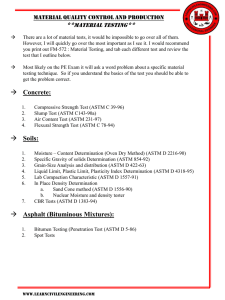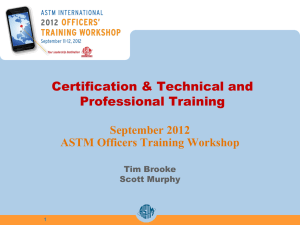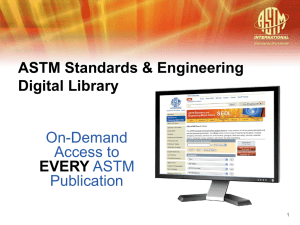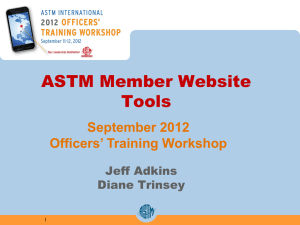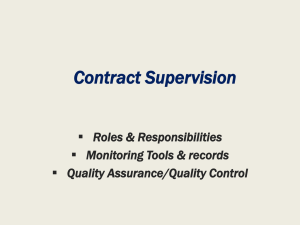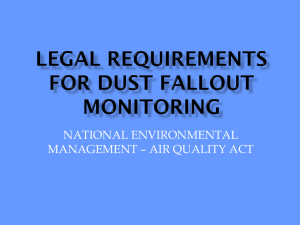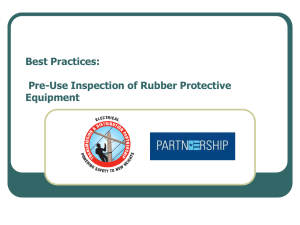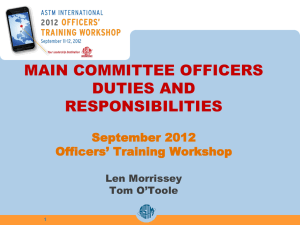Government Interface and Corporate Outreach
advertisement
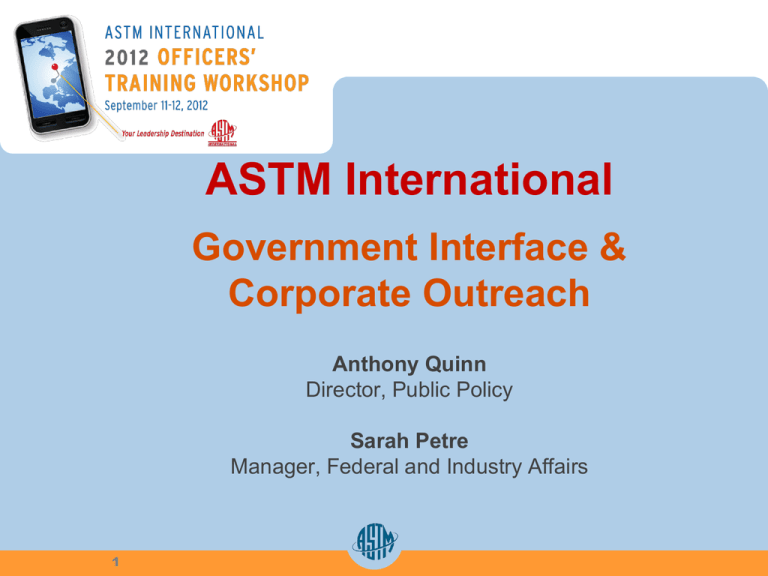
ASTM International Government Interface & Corporate Outreach Anthony Quinn Director, Public Policy Sarah Petre Manager, Federal and Industry Affairs 1 ASTM International About ASTM International • Non-governmental, not-for-profit organization • Develops voluntary, consensus standards • Provides certification programs on limited basis • Does not provide accreditation services ASTM’s objectives • Promote public health and safety, and the overall quality of life • Contribute to the reliability of materials, products, systems and services • Facilitate national, regional, and international commerce 2 Role of Standards Standards in the Public and Private Sector • Impact global trade, innovation and competition • Guide product design, development, market access • Used by companies, research labs, government agencies ASTM International Standards • Voluntary consensus standards • Regularly reviewed • Meet World Trade Organization (WTO) principles for international standards 3 I. Government Interface 4 ASTM in Washington, DC Government Affairs • Congress • Federal government agencies Stakeholder Outreach • Companies • Embassy officials based in Washington • Industry associations • International Non Governmental Organizations (NGOs) 5 ASTM in Washington, DC Connects ASTM’s work and builds awareness among policymakers. Represents ASTM before Congress, federal agencies, ANSI, other SDOs, and trade associations. Engages in legislative, regulatory, and trade matters. Strengthens relationships with ASTM stakeholders 6 Advancing ASTM’s Mission • Remove barriers to the worldwide acceptance and use of ASTM standards. • Ensure proper recognition of ASTM standards in laws and regulations. • Address government policies that duplicate or conflict with the interests of ASTM. • Identify opportunities for new ASTM activities • Government legislation, regulation, and research initiatives create the need for new standards. 7 U.S. Standards System Voluntary and led by the private sector Requires cooperation among stakeholders • Standards organizations • Industry, consumers, and users • Government representatives • Academia Meets stakeholders’ needs • Protect safety, health, and environment • Improve industry competitiveness • Facilitate global trade and market access 8 U.S. Legal and Policy Framework National Technology Transfer and Advancement Act of 1995 (NTTAA) • Requires federal government agencies to use standards developed by voluntary consensus standards organization when possible • Encourages federal government agencies to participate in standards development organizations OMB Circular No. A-119 • Reinforces goals of National Technology Transfer and Advancement Act • Discourages federal agencies from using government-unique standards 9 National Technology Transfer and Advancement Act (NTTAA) “…all Federal agencies and departments shall use technical standards that are developed or adopted by voluntary consensus standards bodies, using such technical standards as a means to carry out policy objectives or activities determined by the agencies and departments…. and shall, when such participation is in the public interest…participate with such bodies in the development of technical standards.” 10 Other U.S. Laws of Interest Consumer Product Safety Act • 15,000 different types of consumer products Food and Drug Administration (FDA) Modernization Act of 1997 • Food safety, drugs, and cosmetic products Occupational Safety and Health Act of 1970 • Workplace safety and health 11 U.S. Government Use of Voluntary Consensus Standards Procurement and Contracts with the Federal Government • Standards are furnished to ensure that materials and services are obtained in an effective manner and in compliance with the provisions of applicable Federal statutes and executive orders Regulation that incorporates standard by reference • An agency may adopt a voluntary standard (without changes) by incorporating the standard in a regulation by listing (or referencing) the standard by title. • This approach eliminates the cost to the agency of creating a new standard Regulation based on existing standard • An agency reviews an existing standard and makes changes to match its goal or need. • Agency conducts rulemaking process to solicit public opinion and stakeholder input Public Notification and Comments • An agency must publish a notice in the Federal Register when making a new rule or incorporating a standard by reference • When creating a new rule based on an existing standard, an agency may change the proposed rule in response to public comments 12 Federal Agencies & ASTM Standards U.S. Code of Federal Regulations (CFR) • 6,500 voluntary consensus standards incorporated by reference in federal law • About 3,000 ASTM standards listed in CFR for regulations and procurement U.S. Federal Register • Public notification of standards adoptions • Instructions for public comments 13 Congress & ASTM Standards in Law Congress may adopt consensus standards by reference into regulation If law is approved, the standard then becomes a mandatory requirement 14 Top 10 Regulatory SDOs in US Standards in US CFR Standards Developing Organization 1 ASTM International ASTM 2227 2 American Society of Mechanical Engineers ASME 599 3 American National Standards Institute ANSI 576 4 Society of Automotive Engineers SAE 418 5 National Fire Protection Association NFPA 380 6 American Petroleum Institute API 270 7 U.S. Environmental Protection Agency EPA 242 8 State of Illinois IL 206 9 Association of Official Analytical Chemists AOAC 199 ICEA 192 10 Insulated Cable Engineers Association 15 Source: http://standards.gov Benefits to the U.S. Government Eliminate/reduce costs of developing standards Decrease costs of good purchased • Commercial off the shelf procurement Promotes efficiency and economic competition Relies on the private sector to meet needs • Access to industry experts and technology • Process is faster and more dynamic 16 U.S. Government Participation in ASTM U.S. Government is a partner and key stakeholder • Active U.S. Government participation in 93% of ASTM committees • Broad range of federal agencies represented on ASTM committees • 1400 units of U.S. Government participation in ASTM • Government participants serve in leadership roles on ASTM Board of Directors 17 U.S. Government Participation in ASTM U.S. Federal Agency ASTM Members Agriculture 17 Commerce (incl. NIST) 190 CPSC U.S. Federal Agency ASTM Members Interior 27 Justice 21 39 NASA 52 Defense 308 NRC 16 Energy 135 OSHA 13 EPA 108 Transportation 90 FAA 12 Treasury 13 HHS (incl. FDA) 136 VA 12 HUD 18 4 ASTM Initiatives with U.S. Government Ensure reference to current standards • Regular review of the Code of Federal Regulations and Congressional Record • Coordinate technical committee communications to policymakers Understand procurement and regulatory standards needs • Review of Regulatory Plan and Agenda • Encourage government liaison with and participation in committee activities 19 Facts and Challenges Standards are not always a top priority • Constant educational process Agencies must use lengthy rulemaking process to update or revise references Roles and attitudes vary across federal agencies At the U.S. state-level, no NTTAA-like policy exists ASTM Strategy Understand agency needs, concerns and goals, and how ASTM fits into their agenda. Communicate Seek advice from agency reps and other committees No one size-fits-all approach • Be flexible to meet the needs of agencies 21 II. Corporate Outreach 22 ASTM Objective “Promote a greater corporate awareness regarding the importance of standards and the value of ASTM.” • ASTM 2006 objectives approved by the Board. 23 ASTM Engages Decision-makers Raise awareness of standards and ASTM Identify opportunities for collaboration on policy (regulatory and trade) issues of mutual interest Seek industry feedback on activities and challenges • including the removal of global barriers to the acceptance and use of ASTM standards Ensure ASTM is meeting stakeholder needs 24 Challenges Executives lack standards knowledge • Casual knowledge of international standardization • View it as technical issue instead of trade barrier Preconceived notions and misinformation • Confusion about what makes an ‘international standard’ Often make quick standards decisions • Easiest or cheapest rather than strategic 25 Benefits to Industry Minimize safety hazards Manage liability while reducing risk Satisfy regulations and laws Facilitate global trade Cost savings by procuring readily available equipment at lower costs Reduce internal company specifications 26 ASTM Standards Impact the Global Economy Standards facilitate trade and boost GDP • The U.S. Commerce Department estimates that standards-related issues impacted 80% of world commodity trade. • In 2000, a German study found the direct economic benefit of standardization was 1% of Gross Domestic Product (GDP). ASTM standards impact the global economy • 84 countries from every region of the world reference ASTM standards in laws or codes • Over 400 ASTM standards references in European legislation since 2001 27 Helping Industry Meet Global Challenges ASTM’s MOUs with 76 developing countries • MOUs facilitate the use of ASTM standards directly into the national portfolios and technical regulations ASTM standards open doors and open markets • Easier to export products made and tested to ASTM standards • Technology transfer improves infrastructure for sourcing 28 MOU Agreements by Region ASIA EUROPE LATIN AMERICA CARIBBEAN MIDDLE EAST & NORTH AFRICA SUB-SAHARAN AFRICA AFGHANISTAN ALBANIA* BOLIVIA BELIZE BAHRAIN BOTSWANA BRUNEI DARUSSALAM BOSNIA CHILE CROSQ EGYPT CONGO CHINA BULGARIA COLOMBIA DOMINICA GCC (GULF STATES) ETHIOPIA INDONESIA CROATIA COSTA RICA DOMINICAN REPUBLIC IRAQ GHANA KOREA KAZAKHSTAN ECUADOR GRENADA ISRAEL KENYA MALAYSIA ROMANIA* EL SALVADOR GUYANA JORDAN MAURITIUS MONGOLIA RUSSIA GUATEMALA JAMAICA MOROCCO MOZAMBIQUE NEPAL SERBIA HONDURAS ST. LUCIA OMAN NIGERIA PAKISTAN PANAMA ST. VINCENT AND THE GRENADINES PALESTINE RWANDA PHILIPPINES PERU TRINIDAD & TOBAGO QATAR SADC SINGAPORE NICARAGUA SAUDI ARABIA SOUTH AFRICA SRI LANKA URUGUAY TUNISIA SWAZILAND TAIWAN TURKEY TANZANIA VIETNAM U.A.E. UGANDA YEMEN ZAMBIA 29 ZIMBABWE ASTM Message to Industry ASTM standards meet World Trade Organization (WTO) criteria for “international standards” • No WTO list of international bodies • WTO recognizes multiple approaches to international standardization ASTM supports industry needs to choose the best standard, regardless of the source ASTM makes it easy to participate in international standards development • Technology drives efficiency 30 WTO Principles for Standards WTO principles: ASTM International principles: • Transparency • Transparency • Openness • Openness • Impartiality and consensus • Impartiality and consensus • Effectiveness and relevance • Effectiveness and relevance • Coherence • Coherence • Consideration of developing nations’ views and concerns • Consideration of developing nations’ views and concerns 31 ASTM Corporate Outreach ASTM is connecting to the business and manufacturing community ASTM Board and Staff completed meetings with industry, trade associations, consumer groups, and other stakeholders around the world • Washington, Stockholm, New York City, Moscow, Mexico City, Brussels, Beijing 32 III. Questions and Discussion 33 Contact Information Anthony Quinn, Director, International Trade and Public Policy aquinn@astm.org, 202 223-8484 Sarah Petre, Manager, Federal and Industry Affairs spetre@astm.org, 202-223-8399 1850 M Street, NW, Suite 1030 Washington, DC 20036 USA 34
